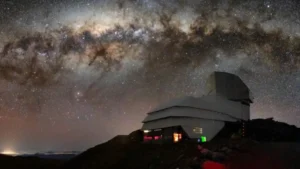On August 23, India became the first country to soft-land a spacecraft near the Moon’s South Pole. In doing so, they have become the fourth country to successfully land on the moon.
“This moment is unforgettable. It is phenomenal. This is a victory cry of a new India…this success belongs to all of humanity, and it will help moon missions by other countries in the future,” said Indian Prime Minister Narendra Modi.
All over India people watched and celebrated the historic moment.

Celebrations break out at the Indian Space Research Organization (ISRO) as India lands on the moon. Photo: ISRO
An unplanned space race
Over the last week, the Indian public has closely followed the progress of Chandrayaan-3. Several temples and mosques have held prayers for a safe landing, and schools showed the landing on big screens. People held watch parties that turned into street parties.
The Indian space program’s success follows just days after Russia’s Luna-25 mission failed to land in the same region. Luna-25 crashed into the moon because of a malfunction.
Though India “won” the unplanned space race, Russian President Vladimir Putin congratulated them. “This is a big step forward in space exploration and of course a testament to the impressive progress made by India in the field of science and technology,” he said.
The Chandrayaan-3 spacecraft launched on July 14 and its lander entered the Moon’s orbit on August 5. It took much longer than most lunar missions because the rockets that launched Chandrayaan-3 were much weaker than those used in other missions. This meant the probe had to orbit Earth multiple times to reach the required speed to reach the Moon.
Sticking the landing
Landing is often the hardest part of lunar missions, the 2019 Chandrayaan-2 mission failed at this stage. The terrain in the South Pole region makes landings particularly hard, with very uneven surfaces dotted with craters. The Vikram lander had to slow from 6,000kph to almost nothing. It also had to flip from a horizontal to a vertical position in only a few minutes during the breaking phase. This was where the Chandrayaan-2 mission failed.
The Indian Space Research Organisation (IRSO) confirmed that it has established communication pathways with the lander and that it has already sent images of the surface of the Moon.
The next phase of the mission involves the lunar rover, Pragyaan, which is inside the lander. Over two weeks, it will conduct experiments. Scientists have detected water ice in the craters of the South Pole, but no one has been able to analyze it.
Chandrayaan-3 Mission:
Updates:The communication link is established between the Ch-3 Lander and MOX-ISTRAC, Bengaluru.
Here are the images from the Lander Horizontal Velocity Camera taken during the descent. #Chandrayaan_3#Ch3 pic.twitter.com/ctjpxZmbom
— ISRO (@isro) August 23, 2023
The Pragyaan rover’s main purpose is to investigate the presence of water ice. This is of huge interest to space agencies. If the water ice is in sufficient quantities, there could be potential for a base on the Moon, allowing astronauts and scientists to stay on the moon for prolonged periods. The rover will also collect data on the geology of the region, the mineral composition of the soil, and seismic activity.
This is the first of a wave of missions headed to the Moon over the next decade. Over a dozen countries, including the U.S., China, and Japan are all gearing up to send spacecraft in this period of renewed interest in Earth’s natural satellite.






